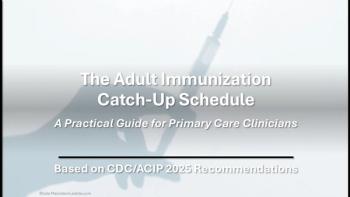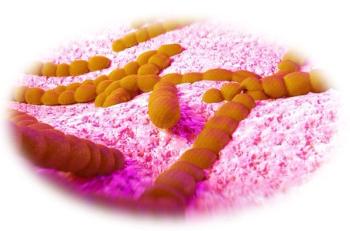
Insect Bite Reaction and Mixed Bacterial Infection
This acute pruritic eruption developed on a 49-year-old woman’s thigh after she had been doing yard work. She promptly sought medical attention at the emergency department. Because cellulitis was suspected, she was given ceftriaxone and an oral cephalosporin was prescribed.
Case 1:
This acute pruritic eruption developed on a 49-year-old woman’s thigh after she had been doing yard work. She promptly sought medical attention at the emergency department. Because cellulitis was suspected, she was given ceftriaxone and an oral cephalosporin was prescribed. However, the eruption has remained unchanged for the past 48 hours. The patient is otherwise healthy. Pending culture results are negative so far.
What is the most appropriate course of action?
A. Continue the cephalosporin.
B. Add rifampin.
C. Switch to levofloxacin.
D. Switch to fluconazole.
E. Add prednisone.
F. Perform a skin biopsy.
(answer on next page)
Case 1: Insect bite reaction
The presence of pruritus and the absence of pain suggested an insect bite reaction rather than an infection. A skin biopsy, F, confirmed the diagnosis, which was further supported by negative bacterial cultures and the lack of response to antibiotics. The patient was given prednisone, E, and the eruption resolved uneventfully.
Case 2:
For 2 days, a 45-year-old woman has had a tender swollen finger after she chewed off a hangnail. She is otherwise healthy. She works as a housecleaner; one of the homes she cleans has 13 toilets. Which of the following do you suspect?
A. Staphylococcus aureus infection.
B. Methicillin-resistant S aureus (MRSA) infection.
C. Candidiasis.
D. Herpes simplex.
E. Gram-negative bacterial infection.
Pending culture results, what would you prescribe?
F. Cephalexin.
G. Levofloxacin.
H.Trimethoprim/sulfamethoxazole (TMP/SMX).
I. Amoxicillin/clavulanate.
J. Rifampin.
K. Fluconazole.
L. Terbinafine.
M.Valacyclovir.
N. Famciclovir.
(answer on next page)
Case 2: Mixed bacterial infection
The culture grew out MRSA (B), Escherichia coli, and Klebsiella organisms (E). TMP/SMX (H) and rifampin (J) had been started pending culture results. The infection resolved uneventfully. Herpes simplex has a sudden onset and should be in the differential. During the first few days of the infection, it can be difficult to distinguish clinically between herpes simplex and a bacterial infection. Mixed bacterial infections can be challenging to diagnose pending culture results, particularly in a patient with this exposure history.
Case 3:
This pruritic facial rash has not responded to fexofenadine, tetracycline, or triamcinolone acetonide. The 33-year-old patient is otherwise healthy.
What is the most likely cause of the rash?
A. Acne.
B. Rosacea.
C. Contact dermatitis.
D. Lupus erythematosus.
E. Polymorphous light eruption.
(answer on next page)
Case 3: Lupus erythematosus
A biopsy confirmed the diagnosis of lupus erythematosus, D. The antinuclear antibody titer was 1:320. The rash markedly diminished after hydroxychloroquine was started and the patient was advised to use sunscreen. Acne and rosacea are reasonable considerations, although they are usually not associated with pruritus. A polymorphous light eruption can mimic cutaneous lupus erythematosus. Contact dermatitis is another possibility that needs to be ruled out by skin biopsy.
Case 4:
A 25-year-old woman presents for evaluation of her moles. She has no particular concerns; however, she does go to a tanning salon regularly. There is no family history of atypical nevi. The physical examination reveals only one suspicious lesion on the proximal posterior left thigh.
What is your clinical impression?
A. Melanoma.
B. Dysplastic nevus.
C. Spitz nevus.
D. Dermatofibroma.
E. Benign vascular nevus.
F. Basal cell carcinoma.
G. Hemangioma.
(answer on next page)
Case 4: Melanoma
A biopsy showed that this lesion was a melanoma, A, with a Breslow depth of invasion of 0.85 mm. A regional sentinel node biopsy was negative. The lesion was excised with adequate margins, and the patient remains disease-free after 2 years.
Amelanotic melanomas are extremely difficult to diagnose clinically because of their lack of pigment. Closer examination reveals asymmetry of the erythema with perhaps a hint of pigment at the inferior aspect of the lesion.
Despite the claims made by the tanning salon industry, the evidence is overwhelming that tanning salons contribute to skin cancer and specifically to melanoma. The amount of UV exposure necessary to ensure adequate vitamin D levels has been grossly exaggerated by the tanning industry; this is contributing to record levels of skin cancer.1-3
References:
REFERENCES:
1
. Han J, Colditz GA, Hunter DJ. Risk factors for skin cancers: a nested casecontrol study within the Nurses’ Health Study.
Int J Epidemiol.
2006;35:1514-1521.
2
. Autier P. Perspectives in melanoma prevention: the case of sunbeds.
Eur J Cancer
. 2004;40:2367-2376.
3
. Levine JA, Sorace M, Spencer J, Siegel DM. The indoor UV tanning industry: a review of skin cancer risk, health benefit claims, and regulation.
J Am Acad Dermato
l. 2005;53:1038-1044.
Newsletter
Enhance your clinical practice with the Patient Care newsletter, offering the latest evidence-based guidelines, diagnostic insights, and treatment strategies for primary care physicians.































































































































































































































































































